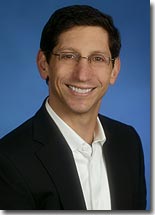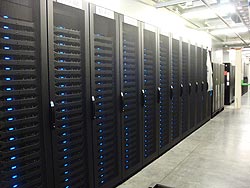REDMOND, Wash., Sept. 14, 2009 — Microsoft is building a new computer lab several miles from the Redmond campus, and the company hopes to shift more than just servers there.

Rob Bernard, Microsoft Chief Environmental Strategist
Dubbed Redmond Ridge 1, the facility aims to consolidate computer labs from the company’s main campus and house servers used for software development and testing. When loaded to full capacity, it will reduce both Microsoft’s operational energy use and costs and will help deliver an estimated carbon savings of 12,000 metric tons per year, says Rob Bernard, Microsoft’s chief environmental strategist.
According to Bernard and other senior executives who took reporters on a tour last week, the building is a symbol of the cultural shift underway at Microsoft from the traditional model, where a product group self-manages their own lab in an office building, to a centrally managed and more energy-efficient alternative.
“The opening of Redmond Ridge is a big milestone and represents a real transition point in the company’s culture,” Bernard says. “This facility is a great example of how technology can help improve the energy efficiency of a company’s operations.”
The building, which opened in July but won’t be fully operational until April 2010, will achieve the energy savings thanks in large part to a state-of-the-art cooling design – evaporative coolers and basic physics cool the facility rather than traditional chillers. Air handlers bring outside air into each enclosed sections of servers and let convection do the work instead of refrigeration. An evaporative cooling system kicks in only when the outside temperature spikes above 75 degrees Fahrenheit. The cooling design, along with other techniques such as dynamic power management, means that servers in the facility will require a third less energy than if they were placed in traditional office buildings, says Jim Osborne, Managed Lab Services product manager.

When loaded to full capacity, Redmond Ridge 1 will reduce both Microsoft’s operational energy use and costs, and will help deliver an estimated carbon savings of 12,000 metric tons per year.
However, traditionally servers have always been in office buildings on the Microsoft campus, which is why engineers can get a little uneasy with the idea they aren’t down the hall during testing and debugging, says Bill Laing, corporate vice president of the Windows Server and Solutions Division. Laing and his group are the first occupants of Redmond Ridge 1, and he acknowledged there was some initial hesitation over the move. “It was a challenge to get people to make the shift that the machines could be physically remote,” he says. But the group and their 80 or so labs did make that shift, and Laing says the move has helped make products such as Windows Server 2008 R2 better. The Windows Server Division now tests builds of Windows Server and other products remotely.
“To me, the move substantially changed the way we thought about the products,” Laing says. “It was also just good environmental practices. When we initially talked about the idea of this facility we didn’t care if it was five miles away or 500. We thought it was the right direction to go in.”
Microsoft anticipates that more product groups will follow suit and adopt a remote development model, though Osborne says not all of the company’s 600 labs worldwide will do so. The continuing shift toward remote development should help Microsoft with its stated goal of reducing its carbon footprint 30 percent by 2012, Bernard says.

Redmond Ridge 1 should cut Microsoft’s carbon footprint thanks to a state-of-the-art cooling design. A state-of-the-art cooling design involving evaporative coolers and basic physics rather than traditional chillers will help cut Microsoft’s carbon footprint.
CIO Tony Scott said that Redmond Ridge 1 demonstrates how a focus on environmental sustainability can also deliver cost savings to businesses. “The energy it takes to run a server now exceeds the cost of the hardware,” Scott says. “At Microsoft IT, our mission is to deliver IT solutions and services that deliver innovation and business value. This facility reminds me of both of those core tenants.”
Redmond Ridge 1 is an important first step in leading to a more efficient way of computing, Bernard says. Once engineers adjust to the idea of a remote development model, the path toward innovation and sustainability will be a much smoother ride. “Crossing the chasm of culture and behavior is much tougher than crossing the chasm of technology,” Bernard says.




